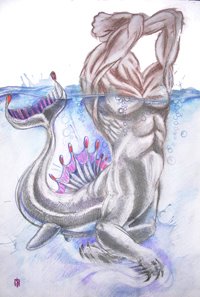Bestiario era el nombre que recibían en la Edad Media los libros donde se describían o trataban animales reales o imaginarios y sus aplicaciones en la simbología religiosa o sus equivalencias con cualidades morales. Fue una de las formas literarias predilectas y era una descripción enciclopédica donde el autor describía y clasificaba las especies y presentaba estos seres en fábulas cortas que podían ser utilizadas como enseñanza moral y religiosa. Al parecer cualquier colegial se sabía el Bestiario de memoria y la "Historia Natural" de Plinio, el fisiólogo, era el libro más difundido después de la Biblia hasta el siglo XII.
En esta conjunto de obras he tratado de mostrar a los seres más extraños y representativos de la mitología popular e indígena de América del Sur.
Estos seres imaginarios, como tales, escapan al rigor de las leyes biológicas y físicas. Han poblado siempre las noches del planeta y también la luz, sin que la era del átomo y la cibernética haya podido acabar con ellos, acaso porque el conocimiento científico y las utopías sociales están aún lejos de calmar todos los miedos ancestrales del ser humano y de colmar sus esperanzas.
BEASTS OF THE WORLD
Bestiario was the name that you/they received in the Half Age the books where they were described or they treated real or imaginary animals and its applications in the religious simbología or its equivalences with moral qualities. It was one in the favorite literary ways and it was an encyclopedic description where the author described and it classified the species and it presented these beings in short fables that could be used as moral teaching and nun. Apparently any schoolboy was known the Bestiario by heart and the Natural History of Plinio, the physiologist was the book more diffused after the Bible until the XII century.
In this group of works I have tried to show to the strangest and representative beings in the popular and indigenous mythology of America of the South.
These imaginary beings, as such, escape to the rigor of the biological and physical laws. They have always populated the nights of the planet and also the light, without the era of the atom and the cybernetics has been able to put an end to them, maybe because the scientific knowledge and the social utopias are still far from calming the human being ancestral fears and of filling their hopes.
Wednesday, September 30, 2009
EL AUTOR / THE AUTHOR

Jorge BernardNació en Mendoza, Argentina, en 1962. Estudió Artes Plásticas en la Universidad Nacional de Cuyo, Mendoza.Expuso dibujos, pinturas, historietas y dibujos animados en salas de Argentinay Chile. Trabajó para revistas de historietas, realizando guiones, cómics y portadas.En el campo publicitario de desempeñó como ilustrador, realizador independiente dedibujos animados y como Director de Arte para diversas agencias de publicidad.Se ha desempeñado también como Director de Arte Digital en Canal 7, de Mendoza.Actualmente reside en la provincia de Tierra del Fuego, Argentina, desempeñándosecomo Director de Arte en TV Fuego.
Jorge BernardHe was born in Mendoza, Argentina, in 1962. He studied plastic arts in the National University of Whose, Mendoza.It exposed drawings, paintings, comics and cartoons in rooms of Argentinaand Chile. He worked for magazines of comics, carrying out scripts, cómics and covers.In the advertising field of it carried out as illustrator, independent realizador ofcartoons and as Director of Art for diverse agencies of publicity.He has also acted as Director of Digital Art in Channel 7, of Mendoza.At the moment it resides in the county of Earth of the Fire, Argentina, actingas Director of Art in TV Fuego.
AHÓ AHÓ

Animal mítico de la región guaraní de terrible aspecto. Es semejante a una oveja pero de grandes garras y devora a los que encuentra en el monte. La única salvación es subirse a una palmera, árbol sagrado que no se atreverá a profanar. Si el perseguido se trepa a cualquier otro árbol, el Ahó-Ahó lo derribará cavando con sus potentes uñas, para devorarlo ni bien caiga al suelo.
Sospecha Ambrosetti que esta leyenda fue difundida por los padres jesuitas en las misiones del Alto Paraná para evitar que los guaraníes se alejaran de las reducciones, por temor a que desertaran, se perdieran en el monte o fueran victimados por los tigres o los indios no reducidos, que siempre merodeaban por los alrededores.
Mythical animal of the Guarani region of terrible aspect. It is similar to a sheep but of big claws and it devours those that he/she finds in the mount. The only salvation is to be gone up to a palm, sacred tree that won't dare to profane. If the one pursued you climbs to any other tree, the Ahó-Ahó will demolish it digging with its potent fingernails, to devour it neither well fall to the floor.
Ambrosetti that this legend was diffused by the parents Jesuit in the missions of the High Paraná to avoid the Guarani to move away from the reductions fearing that deserted, suspects they got lost in the mount or they were killed by the tigers or the not reduced Indians that always marauded for the surroundings.
Sospecha Ambrosetti que esta leyenda fue difundida por los padres jesuitas en las misiones del Alto Paraná para evitar que los guaraníes se alejaran de las reducciones, por temor a que desertaran, se perdieran en el monte o fueran victimados por los tigres o los indios no reducidos, que siempre merodeaban por los alrededores.
Mythical animal of the Guarani region of terrible aspect. It is similar to a sheep but of big claws and it devours those that he/she finds in the mount. The only salvation is to be gone up to a palm, sacred tree that won't dare to profane. If the one pursued you climbs to any other tree, the Ahó-Ahó will demolish it digging with its potent fingernails, to devour it neither well fall to the floor.
Ambrosetti that this legend was diffused by the parents Jesuit in the missions of the High Paraná to avoid the Guarani to move away from the reductions fearing that deserted, suspects they got lost in the mount or they were killed by the tigers or the not reduced Indians that always marauded for the surroundings.
EL FUTRE

El origen de este mito es mendocino, se sitúa en Puente del Inca, Mendoza, Argentina, y de ahí con diversas variantes, se extendió a otros puntos de la provincia y San Juan. Hay por lo menos dos versiones. Una dice que se trataría de un inglés bien vestido ( de ahí su nombre, pues se llama “futre” en Cuyo, a toda persona que viste elegantemente) que, tras haberlo perdido todo en la sala de juegos del hotel de esa localidad, salió vestido de frac en plena noche y se perdió entre los cerros nevados.
La otra versión dice que se trataba de un hombre humilde que trabajaba en el ferrocarril, que fue asesinado y decapitado por el amante de su esposa en la misma estación de Puente del Inca. Unos dicen que éste anda de noche con la cabeza en la mano y un hacha en la otra, amenazando a los que encuentra, mientras otros aseguran que se trata de un espectro inofensivo. En ambas versiones a veces el Futre aparece a caballo.
The origin of this myth is from Mendoza, it is located in Bridge of the Inca, Mendoza, and of there with diverse variants, he/she extended to other points of the county and San Juan. There is at least two versions. One says that it would be an English very dress (of there their name, because " futre " is called in Whose, to all person that you dressed elegantly) that, after having him lost everything in the room of games of the hotel of that town, tuxedo dress came out in full night and he got lost among the snowy hills.
The other version says that it was a humble man that worked in the railroad that was murdered and beheaded by its wife's lover in the same station of Bridge of the Inca. Some say that this walks at night with the head in the hand and an axe in the other one, threatening those that finds, while others assure that it is an inoffensive spectrum. In both versions the Futre sometimes appears to horse.
Furufuhué

Ente mitológico vinculado con el viento, infaltable en el sur de nuestro continente, con velocidades que a veces no permiten mantenerse en pie. Se lo describe como un pájaro cuyo cuerpo esta cubierto de escamas refulgentes en vez de plumas, y que solo puede ser visto a contrasol.
Nadie sabe donde anida ni de donde viene, pero explican que su potente silbido puede oirse de cualquier lugar de la Tierra. Este mito, original de la región meridional de Argentina y Chile se esta extinguiendo junto con lo indígenas, son actualmente muy pocos los habitantes de la zona, mestizos, criollos, colonos o descendientes de colonizadores europeos que lo conozcan.
Mythological entity linked with the wind, own in the south of our continent, with speeds that don't sometimes allow to stay in foot. It describes it to him as a bird whose body this covered with radiant flakes instead of feathers, and that alone it can be seen to back lighting.
Nobody knows where it nests neither of where he/she comes, but they explain that their potent whistle can be heard of any place of the Earth. This myth, original of the southern region of Argentina and Chile you this extinguishing together with the indigenous ones, they are at the moment very few the inhabitants of the area, mestizos, Creoles, colonists or European settlers' descendants that know it.
Nadie sabe donde anida ni de donde viene, pero explican que su potente silbido puede oirse de cualquier lugar de la Tierra. Este mito, original de la región meridional de Argentina y Chile se esta extinguiendo junto con lo indígenas, son actualmente muy pocos los habitantes de la zona, mestizos, criollos, colonos o descendientes de colonizadores europeos que lo conozcan.
Mythological entity linked with the wind, own in the south of our continent, with speeds that don't sometimes allow to stay in foot. It describes it to him as a bird whose body this covered with radiant flakes instead of feathers, and that alone it can be seen to back lighting.
Nobody knows where it nests neither of where he/she comes, but they explain that their potent whistle can be heard of any place of the Earth. This myth, original of the southern region of Argentina and Chile you this extinguishing together with the indigenous ones, they are at the moment very few the inhabitants of the area, mestizos, Creoles, colonists or European settlers' descendants that know it.
HUAYRAPUCA

Personaje fabuloso de dos o tres cabezas que puede hacer tanto el bien como el mal. En un extremo de su cuerpo puede tener una monstruosa cabeza de dragón y en el otro una de serpiente. Vive en las altas cumbres y en los profundos abismos montañosos. Sus malos sentimientos se manifiestan cuando destruye las cosechas y se afana por prolongar la sequía. Para conseguir esto se traba en encarnizada lucha con Puyuspa, el nublado, su eterno enemigo. Recorre las llanuras absorbiendo la humedad de plantas y secando la garganta de los animales, que mugen lastimeramente.
Fabulous character of two or three heads that he/she can make so much well the as the wrong. In an end of their body he/she can have a monstrous dragon head and in the other one one of snake. He/she lives in the high summits and in the deep mountainous abysses. Their bad feelings are manifested when it destroys the crops and he/she toils to prolong the drought. To get this it is begun in bloody fight with Puyuspa, the cloudy one, their eternal enemy. It travels the plains absorbing the humidity of plants and the throat of the animals that you/they moo plaintively drying off.
Fabulous character of two or three heads that he/she can make so much well the as the wrong. In an end of their body he/she can have a monstrous dragon head and in the other one one of snake. He/she lives in the high summits and in the deep mountainous abysses. Their bad feelings are manifested when it destroys the crops and he/she toils to prolong the drought. To get this it is begun in bloody fight with Puyuspa, the cloudy one, their eternal enemy. It travels the plains absorbing the humidity of plants and the throat of the animals that you/they moo plaintively drying off.
KAPARILO

Leyenda de los montes de Copo, en Santiago del Estero. En este ser toman forma todos los ruidos extraños en un ser poco definido, que puede tomar la forma de una bola de carne. Entre sus características está la de hacerse invisible, y también la de modular sus gritos de modo que se acerquen y alejen arbitrariamente, sembrando miedo y desconcierto. Suele rondar los ranchos cuando los hombres se han ausentado.
Legend of the mounts of Flake, in Santiago of the Tideland. In this being they take form all the strange noises in a not very defined being that can take the form of a meat ball. among their characteristics it is the one of becoming invisible, and also the one of modulating their screams so that they come closer and move away arbitrarily, sowing fear and bewilderment. It is usually about the ranches when the men have been absent.
Legend of the mounts of Flake, in Santiago of the Tideland. In this being they take form all the strange noises in a not very defined being that can take the form of a meat ball. among their characteristics it is the one of becoming invisible, and also the one of modulating their screams so that they come closer and move away arbitrarily, sowing fear and bewilderment. It is usually about the ranches when the men have been absent.
TORO SÚPAY

Toro Diablo. Conocido en Santiago del Estero, especialmente en los salvages montes del río Saladillo y el resto de la región saladina. Ricardo Rojas lo describe como de estatura gigantesca, cabeza redonda, entre humana y taurina, de cuello erguido y cola y nuca cerdosas. Echa humo sulfuroso por las narices, y su boca parece una trompa llena de bramidos. Otras descripciones recogidas por Bravo y Franco, destacan sus cuernos de oro.
Protege la hacienda, y le da un grado de prosperidad inalcanzable por medios naturales. Pero es preciso para esto que el dueño de la misma haya realizado un pacto con el Súpay. A la muerte del dueño, éste no sólo cargará con su alma, sino también la hacienda. Al amanecer del día siguiente, mientras dure el velorio, los corrales estarán vacíos.
Protege la hacienda, y le da un grado de prosperidad inalcanzable por medios naturales. Pero es preciso para esto que el dueño de la misma haya realizado un pacto con el Súpay. A la muerte del dueño, éste no sólo cargará con su alma, sino también la hacienda. Al amanecer del día siguiente, mientras dure el velorio, los corrales estarán vacíos.
Bull Devil. Well-known in Santiago of the Tideland, especially in the salvages mounts of the river Saladillo and the rest of the region saladina. Red Ricardo describes it as of gigantic stature, round head, between human and taurine, of erect neck and line and bristly nape. It tosses sulfurous smoke for the noses, and their mouth seems a trumpet full with bellows. Other descriptions picked up for Bravo and Franco, they highlight their horns of gold.
It protects the country property, and he/she gives him a degree of unreachable prosperity for natural means. But it is necessary for this that the owner of the same one has carried out a pact with the Súpay. To the owner's death, this won't only load with their soul, but also the country property. To the dawn of the following day, while the wake lasts, the corrals will be empty.
It protects the country property, and he/she gives him a degree of unreachable prosperity for natural means. But it is necessary for this that the owner of the same one has carried out a pact with the Súpay. To the owner's death, this won't only load with their soul, but also the country property. To the dawn of the following day, while the wake lasts, the corrals will be empty.
TREN TREN FILU VENCE A KAY KAY FILU

Kay Kay Filú, la serpiente enemiga de la vida, convocó a las aguas para cubrir la tierra y acabar con los hombres y animales. Tren Tren Filú, aliada de la gente, organizó la defensa rogando a los cerros que crecieran a la par de la inundación. Hombres y mujeres treparon a cada loma, pero algunos no llegaron, son peces, son rocas. Los que consiguieron lugar en las alturas salvaron suy vida y en espera de que las aguas bajaran, expuestos de cerca al sol, quedaron morenos. Ellos son los mapuche, la gente de la tierra ( de mapu: tierra y che: gente).
Así es el génesis del pueblo mapuche, transmitido de abuelo a abuelo a través de los siglos.
Kay Kay Filú, the enemy snake of the life, summoned to the waters to cover the earth and to put an end to the men and animals. Tren Tren Filú, allied of people, it organized the defense requesting to the hills that grew at the same time of the flood. Men and women climbed to each hill, but some didn't arrive, they are fish, they are rocks. Those that got place in the heights saved suy life and while waiting for that the waters lowered, exposed closely in the sun, they were brown. They are the mapuche, people of the earth (of mapu: earth and che: people).
It is this way the genesis of the town mapuche, transmitted of grandfather to grandfather through the centuries.
Así es el génesis del pueblo mapuche, transmitido de abuelo a abuelo a través de los siglos.
Kay Kay Filú, the enemy snake of the life, summoned to the waters to cover the earth and to put an end to the men and animals. Tren Tren Filú, allied of people, it organized the defense requesting to the hills that grew at the same time of the flood. Men and women climbed to each hill, but some didn't arrive, they are fish, they are rocks. Those that got place in the heights saved suy life and while waiting for that the waters lowered, exposed closely in the sun, they were brown. They are the mapuche, people of the earth (of mapu: earth and che: people).
It is this way the genesis of the town mapuche, transmitted of grandfather to grandfather through the centuries.
VIEJO DE LA BOLSA

Personaje legendario que vaga por las calles de pueblos y ciudades, cargando en sus hombros una enorme bolsa en la que guarda los más variados elementos, todo lo que encuentra o puede robar por ahí, su aspecto es temible aunque nunca se lo puede ver con precisión. Suele cargar en su bolsa a los niños que no hacen caso a sus padres para llevárselos con él a vivir a su guarida en el basural.
Legendary character that wanders for the streets of towns and cities, loading in their shoulders an enormous bag in which keeps the most varied elements, all that finds or he/she can steal somewhere around, their aspect is terrible although he can never see accurately it. It usually loads in their bag to the children that don't pay attention to their parents to be taken them with him to live to their den in the landfill.
Legendary character that wanders for the streets of towns and cities, loading in their shoulders an enormous bag in which keeps the most varied elements, all that finds or he/she can steal somewhere around, their aspect is terrible although he can never see accurately it. It usually loads in their bag to the children that don't pay attention to their parents to be taken them with him to live to their den in the landfill.
YAGUARETÉ ABÁ

Hombre tigre, leyenda muy difundida en Corrientes, Misiones y Paraguay.
Son viejos indios bautizados que de noche se vuelven yaguaretés para comerse
a sus compañeros u otras personas. Cuando les viene el mal propósito se alejan de sus semejantes y se sumergen en la oscuridad de la noche, buscando el abrigo de un matorral. Allí empiezan a revolcarse de izquierda a derecha sobre un cuero de jaguar, rezando un credo al revés mientras cambian de aspecto. Salen entonces de caza, y ya devorada la presa, retoman a su forma primitiva, realizando la misma operación, pero ahora en sentido inverso.
Son viejos indios bautizados que de noche se vuelven yaguaretés para comerse
a sus compañeros u otras personas. Cuando les viene el mal propósito se alejan de sus semejantes y se sumergen en la oscuridad de la noche, buscando el abrigo de un matorral. Allí empiezan a revolcarse de izquierda a derecha sobre un cuero de jaguar, rezando un credo al revés mientras cambian de aspecto. Salen entonces de caza, y ya devorada la presa, retoman a su forma primitiva, realizando la misma operación, pero ahora en sentido inverso.
Man tiger, legend very diffused in Corrientes, Missions and Paraguay.
They are old baptized Indians that at night they become yaguaretés to eat up
to their partners or other people. When he/she comes them the bad purpose they move away from their fellow men and they dive in the darkness of the night, looking for the coat of a heath. There they begin to flail from left to right on a jaguar leather, praying a credo the other way around while they change aspect. They leave hunt then, and already devoured the prey, they recapture to their primitive form, carrying out the same operation, but now in inverse sense.
They are old baptized Indians that at night they become yaguaretés to eat up
to their partners or other people. When he/she comes them the bad purpose they move away from their fellow men and they dive in the darkness of the night, looking for the coat of a heath. There they begin to flail from left to right on a jaguar leather, praying a credo the other way around while they change aspect. They leave hunt then, and already devoured the prey, they recapture to their primitive form, carrying out the same operation, but now in inverse sense.
BESTIARIO CARTOON
Esta serie de obras las he realizado de manera digital, excepto los fondos de las mismas que fueron hechas a mano. Las he llamado Bestiario Cartoon, porque están diseñadas con un criterio de cómic o de animación, y están más orientadas al conocimiento infantil de la mitología indoamericana.
This series of works has carried out them in a digital way, except the funds of the same ones that were made by hand. I have called them Bestiario Cartoon, because they are designed with a cómic approach or of animation, and they are more guided the infantile knowledge of the aboriginal mythology and American.
This series of works has carried out them in a digital way, except the funds of the same ones that were made by hand. I have called them Bestiario Cartoon, because they are designed with a cómic approach or of animation, and they are more guided the infantile knowledge of the aboriginal mythology and American.
Basilisco

Antigua leyenda de origen probablemente oriental, introducida en Europa por los romanos. Plinio habló del Basilisco y varios artistas se ocuparon de su iconografía. Es un híbrido nacido de la fecundación de un huevo de culebra por un sapo al que se describe como un animal verdaderamente fabuloso, algo semejante al dragón, con patas de gallina y cola de serpiente, una cresta en la cabeza y por lo común provisto de alas, su aliento pudre el aire, envenena las aguas y marchita todo verdor. Huye de la luz del día escondiéndose en los techos de las casas, para fulminar desde allí, con su diabólica mirada a los desdichados que se dejan sorprender.
THE BASILISK
Antigua legend of probably oriental origin, introduced in Europe by the Romans. Plinio spoke of the Basilisk and several artists were in charge of of its iconography. It is a hybrid one born of the fecundation of a snake egg for a toad to the one that is described as a truly fabulous animal, something similar to the dragon, with hen paws and snake line, a crest in the head and in general provided of wings, their encouragement rots the air, it poisons the waters and it withers all greenery. He/she escapes from the light of the day hiding in the roofs of the houses, to fulminate from there, with their diabolical look to the unhappy ones that are allowed to surprise.
THE BASILISK
Antigua legend of probably oriental origin, introduced in Europe by the Romans. Plinio spoke of the Basilisk and several artists were in charge of of its iconography. It is a hybrid one born of the fecundation of a snake egg for a toad to the one that is described as a truly fabulous animal, something similar to the dragon, with hen paws and snake line, a crest in the head and in general provided of wings, their encouragement rots the air, it poisons the waters and it withers all greenery. He/she escapes from the light of the day hiding in the roofs of the houses, to fulminate from there, with their diabolical look to the unhappy ones that are allowed to surprise.
Chancha con Cadenas

En el norte de Santiago del Estero, se dice que por las inmediaciones de las vías del ferrocarril, en noches de luna llena. merodea una chancha del demonio que arrastra pesadas cadenas con las que hace un ruido espeluznante y aterroriza a los pobladores. Otras versiones dicen que corre como enloquecida por los cables del teléfono.
PIG WITH CHAINS
In the north of Santiago of the Tideland, it is said that for the vicinity of the roads of the railroad, in nights of full moon. the demon's pig that drags heavy chains with those that he/she makes a thrilling noise marauds and it terrifies the residents. Other versions say that he/she runs as gone mad by the cables of the telephone.
PIG WITH CHAINS
In the north of Santiago of the Tideland, it is said that for the vicinity of the roads of the railroad, in nights of full moon. the demon's pig that drags heavy chains with those that he/she makes a thrilling noise marauds and it terrifies the residents. Other versions say that he/she runs as gone mad by the cables of the telephone.
ELENGASEM

De la mitología Tehuelche quedan relatos incompletos, donde se destaca la figura del ELEMGASEM, padre o generador de la raza que vive en una cueva, al que se le atribuye la autoría de las pinturas rupestres.
"Gran animal extraño, cubierto de enorme cáscara, muy gruesa parecida a la de los armadillos actuales o de piedra. Robaba mujeres y tenía según algunos cara humana y según otros era un hombre de talla gigantesca cubierta la espalda de una enorme coraza."
Los Günün-a-küna tenían un canto dedicado al Elemgasem y decían que era el "dueño" de todos los animales vivientes y que sólo podía ser muerto por el rayo. Raspaban los huesos del Elemgasem (cualquier fósil hallado) y se lo daban a beber a los niños para que sean fuertes y sanos.
ELEMGASEM
Of the mythology Tehuelche is incomplete stories, where he stands out the figure of the ELEMGASEM, father or generator of the race that he lives in a cave, to which is attributed the responsibility of the paintings rupestres.
"Great strange animal, covered with enormous shell, very thick similar to that of the current armadillos or of stone. He stole women and he had according to some human face and according to other he was a man of size gigantic cover the back of an enormous armor."
"Gran animal extraño, cubierto de enorme cáscara, muy gruesa parecida a la de los armadillos actuales o de piedra. Robaba mujeres y tenía según algunos cara humana y según otros era un hombre de talla gigantesca cubierta la espalda de una enorme coraza."
Los Günün-a-küna tenían un canto dedicado al Elemgasem y decían que era el "dueño" de todos los animales vivientes y que sólo podía ser muerto por el rayo. Raspaban los huesos del Elemgasem (cualquier fósil hallado) y se lo daban a beber a los niños para que sean fuertes y sanos.
ELEMGASEM
Of the mythology Tehuelche is incomplete stories, where he stands out the figure of the ELEMGASEM, father or generator of the race that he lives in a cave, to which is attributed the responsibility of the paintings rupestres.
"Great strange animal, covered with enormous shell, very thick similar to that of the current armadillos or of stone. He stole women and he had according to some human face and according to other he was a man of size gigantic cover the back of an enormous armor."
GURUVILU

Deidad araucana del agua, que vive en ríos y lagunas y rara vez sale a la tierra. Cuando lo hace, tirita como si estuviera muriendo de frío. Ser masculino. Se lo representa con la forma de un gato salvaje cuya cola termina en una garra terrible, con la que envuelve a los navegantes, bañistas y jinetes para llevarlos al fondo y ahogarlos. Se dice que tanta es su fuerza, que puede arrastrar un hombre a caballo.
THE GURUVILU
Araucanian deity of the water that he lives in rivers and lagoons and rarely it leaves to the earth. When he makes it, he shivers as if he was dying from cold. To be masculine. It represents it to him with the form of a wild cat whose line finishes in a terrible claw, with which wraps the navigators, swimmers and horsemen to take them to the bottom and to drown them. It is said that so much is their force that a man can drag horse.
THE GURUVILU
Araucanian deity of the water that he lives in rivers and lagoons and rarely it leaves to the earth. When he makes it, he shivers as if he was dying from cold. To be masculine. It represents it to him with the form of a wild cat whose line finishes in a terrible claw, with which wraps the navigators, swimmers and horsemen to take them to the bottom and to drown them. It is said that so much is their force that a man can drag horse.
HUAYLLIPENYÚ

Dios mapuche de la niebla, que vive en el borde de los ríos, lagos y en la costa del mar. Ser masculino al que se representa con cuerpo de carnero, cabeza de ternero y la parte posterior de foca. Otras descripciones lo presentan con cuerpo de foca y patas de carnero, siendo las delanteras cortas y torcidas y paralíticas las traseras, lo cual no le impide ser veloz, fuerte y bravo.
Sale a la noche para acoplarse con animales domésticos, siendo sus crías tan deformes como él, y con elementos ajenos a la especie de su madre. También se acopla con mujeres, y los hijos salen mitad hombre y mitad bestia.
HUAILLEPENYÚ
God mapuche of the fog that lives in the border of the rivers, lakes and in the coast of the sea. To be masculine to which is represented with ram body, calf head and the later part of seal. Other descriptions present it with seal body and ram paws, being the short and bent leading and paralytics the back ones, that which doesn't prevent him to be speedy, strong and brave.
It leaves at night to be coupled with domestic animals, being their breedings so unsightly as him, and with elements unaware to their mother's species. It is also coupled with women, and the children leave half man and half beast.
Sale a la noche para acoplarse con animales domésticos, siendo sus crías tan deformes como él, y con elementos ajenos a la especie de su madre. También se acopla con mujeres, y los hijos salen mitad hombre y mitad bestia.
HUAILLEPENYÚ
God mapuche of the fog that lives in the border of the rivers, lakes and in the coast of the sea. To be masculine to which is represented with ram body, calf head and the later part of seal. Other descriptions present it with seal body and ram paws, being the short and bent leading and paralytics the back ones, that which doesn't prevent him to be speedy, strong and brave.
It leaves at night to be coupled with domestic animals, being their breedings so unsightly as him, and with elements unaware to their mother's species. It is also coupled with women, and the children leave half man and half beast.
HUAYRAPUCA

Personaje fabuloso de dos o tres cabezas que puede hacer tanto el bien como el mal. En un extremo de su cuerpo puede tener una monstruosa cabeza de dragón y en el otro una de serpiente. Vive en las altas cumbres y en los profundos abismos montañosos. Sus malos sentimientos se manifiestan cuando destruye las cosechas y se afana por prolongar la sequía. Para conseguir esto se traba en encarnizada lucha con Puyuspa, el nublado, su eterno enemigo. Recorre las llanuras absorbiendo la humedad de plantas y secando la garganta de los animales, que mugen lastimeramente.
HUAYRAPUCA
Fabulous character of two or three heads that he/she can make so much well the as the wrong. In an end of their body he/she can have a monstrous dragon head and in the other one one of snake. He/she lives in the high summits and in the deep mountainous abysses. Their bad feelings are manifested when it destroys the crops and he/she toils to prolong the drought. To get this it is begun in bloody fight with Puyuspa, the cloudy one, their eternal enemy. It travels the plains absorbing the humidity of plants and the throat of the animals that you/they moo plaintively drying off.
HUAYRAPUCA
Fabulous character of two or three heads that he/she can make so much well the as the wrong. In an end of their body he/she can have a monstrous dragon head and in the other one one of snake. He/she lives in the high summits and in the deep mountainous abysses. Their bad feelings are manifested when it destroys the crops and he/she toils to prolong the drought. To get this it is begun in bloody fight with Puyuspa, the cloudy one, their eternal enemy. It travels the plains absorbing the humidity of plants and the throat of the animals that you/they moo plaintively drying off.
KAY KAY FILÚ

Kay Kay Filú, la serpiente enemiga de la vida, convocó a las aguas para cubrir la tierra y acabar con los hombres y animales. Tren Tren Filú, aliada de la gente, organizó la defensa rogando a los cerros que crecieran a la par de la inundación. Hombres y mujeres treparon a cada loma, pero algunos no llegaron, son peces, son rocas. Los que consiguieron lugar en las alturas salvaron suy vida y en espera de que las aguas bajaran, expuestos de cerca al sol, quedaron morenos. Ellos son los mapuche, la gente de la tierra ( de mapu: tierra y che: gente).
Así es el génesis del pueblo mapuche, transmitido de abuelo a abuelo a través de los siglos.
Así es el génesis del pueblo mapuche, transmitido de abuelo a abuelo a través de los siglos.
Kay Kay Filú, the enemy snake of the life, summoned to the waters to cover the earth and to put an end to the men and animals. Tren Tren Filú, allied of people, it organized the defense requesting to the hills that grew at the same time of the flood. Men and women climbed to each hill, but some didn't arrive, they are fish, they are rocks. Those that got place in the heights saved suy life and while waiting for that the waters lowered, exposed closely in the sun, they were brown. They are the mapuche, people of the earth (of mapu: earth and che: people).
It is this way the genesis of the town mapuche, transmitted of grandfather to grandfather through the centuries.
It is this way the genesis of the town mapuche, transmitted of grandfather to grandfather through the centuries.
Taiyín

Poderoso chamán del pueblo Shelk’nam quién gravitó de manera importante en el universo espiritual de los onas, decapitó con su honda a la despiadada Taita (Che’Enem), quién había provocado una gran hambruna y controlaba las costas de Tierra del Fuego. Este poderoso guerrero conocido también como Shenu K’ Tam, es el colibrí en el génesis de los shelk’nam. Luego de ultimar a Taita, tomó el arco y las flechas que ella tenía, y se las mostró al pueblo para que ellos aprendieran a fabricarlas. Luego lanzando piedras con su honda, originó lagos y lagunas, y con otra piedra abrió un canal al norte generando apertura del Estrecho de Magallanes. Luego voló al continente y no volvió más a la isla.
TÁIYIN
Powerful chamán of the town Shelk'nam who gravitated in an important way in the spiritual universe of the onas, it beheaded with their sling to the merciless Taita (Che'Enem), who it had caused a great famine and it controlled the costs of Earth of the Fire. This powerful well-known warrior also as Shenu K' Tam, is the hummingbird in the genesis of the shelk'nam. after finishing Taita, he took the arch and the arrows that she had, and it showed them to the town so that they learned how to manufacture them. Then throwing stones with their sling, it originated lakes and lagoons, and with another stone he opened a channel to the north generating opening of Magellan's Strait. Then it flew to the containing one and it didn't return more to the island.
TÁIYIN
Powerful chamán of the town Shelk'nam who gravitated in an important way in the spiritual universe of the onas, it beheaded with their sling to the merciless Taita (Che'Enem), who it had caused a great famine and it controlled the costs of Earth of the Fire. This powerful well-known warrior also as Shenu K' Tam, is the hummingbird in the genesis of the shelk'nam. after finishing Taita, he took the arch and the arrows that she had, and it showed them to the town so that they learned how to manufacture them. Then throwing stones with their sling, it originated lakes and lagoons, and with another stone he opened a channel to the north generating opening of Magellan's Strait. Then it flew to the containing one and it didn't return more to the island.
Yaguareté Abá

Hombre tigre, leyenda muy difundida en Corrientes, Misiones y Paraguay.
Son viejos indios bautizados que de noche se vuelven yaguaretés para comerse
a sus compañeros u otras personas. Cuando les viene el mal propósito se alejan de sus semejantes y se sumergen en la oscuridad de la noche, buscando el abrigo de un matorral. Allí empiezan a revolcarse de izquierda a derecha sobre un cuero de jaguar, rezando un credo al revés mientras cambian de aspecto. Salen entonces de caza, y ya devorada la presa, retoman a su forma primitiva, realizando la misma operación, pero ahora en sentido inverso.
THE YAGUARETÉ-ABÁ
Man tiger, legend very diffused in Corrientes, Missions and Paraguay.
They are old baptized Indians that at night they become yaguaretés to eat up
to their partners or other people. When he/she comes them the bad purpose they move away from their fellow men and they dive in the darkness of the night, looking for the coat of a heath. There they begin to flail from left to right on a jaguar leather, praying a credo the other way around while they change aspect. They leave hunt then, and already devoured the prey, they recapture to their primitive form, carrying out the same operation, but now in inverse sense.
Son viejos indios bautizados que de noche se vuelven yaguaretés para comerse
a sus compañeros u otras personas. Cuando les viene el mal propósito se alejan de sus semejantes y se sumergen en la oscuridad de la noche, buscando el abrigo de un matorral. Allí empiezan a revolcarse de izquierda a derecha sobre un cuero de jaguar, rezando un credo al revés mientras cambian de aspecto. Salen entonces de caza, y ya devorada la presa, retoman a su forma primitiva, realizando la misma operación, pero ahora en sentido inverso.
THE YAGUARETÉ-ABÁ
Man tiger, legend very diffused in Corrientes, Missions and Paraguay.
They are old baptized Indians that at night they become yaguaretés to eat up
to their partners or other people. When he/she comes them the bad purpose they move away from their fellow men and they dive in the darkness of the night, looking for the coat of a heath. There they begin to flail from left to right on a jaguar leather, praying a credo the other way around while they change aspect. They leave hunt then, and already devoured the prey, they recapture to their primitive form, carrying out the same operation, but now in inverse sense.
Cumanga

Criatura fabulosa de las tradiciones brasileñas.La cumanga es una versión femenina del hombre lobo, que posee una particularidad: su cabeza puede separarse del cuerpo y volar como una bola de fuego. La visión de éste fenómeno es tan horrible que lleva a los testigos a la locura.Según la leyenda, la cumanga es una mujer que mantuvo relaciones prohibidas. Según otras versiones, se trata de la séptima hija de una unión ilegítima.
Fabulous creature of the traditions of the Brazil. The cumanga is the man's wolf feminine version that possesses a particularity: their head can separate the body and to fly like a fire ball. The vision of this phenomenon is so horrible that it takes to the witness to become crazy. According to the legend, the cumanga is a woman that maintained forbidden relationships. According to other versions, it is the seventh daughter of an illegitimate union.
Capelobo

El capelobo o cupelobo, es un ser demoníaco de las tradiciones del Brasil. Tiene cuerpo humano y cabeza de tapir y pueden considerarse similitudes con el Hombre- Lobo. Incluso se lo suele considerar como el Lobizón de los indígenas. Sale por las noches y ronda los campamentos para matar perros y gatos con los que se alimenta. Si el Capelobo se cruza con un eventual cazador, lo atacará en la carótida y beberá su sangre.
The capelobo or cupelobo, are a being of the devil of the traditions of the Brazil. He has human body and tapir head and they can be considered similarities with the Man - Wolf. It usually considers even it to him as the Man - Wolf of the natives. It leaves for the nights and beat the camps to kill dogs and cats with those that he feeds. If the Capelobo crosses with an eventual hunter, it will attack it in the carotid and he/she will drink its blood.
Tuesday, February 07, 2006
AHÓ-AHÓ
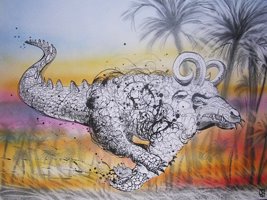
Animal mítico de la región guaraní de terrible aspecto. Es semejante a una oveja pero de grandes garras y devora a los que encuentra en el monte. La única salvación es subirse a una palmera, árbol sagrado que no se atreverá a profanar. Si el perseguido se trepa a cualquier otro árbol, el Ahó-Ahó lo derribará cavando con sus potentes uñas, para devorarlo ni bien caiga al suelo.
Sospecha Ambrosetti que esta leyenda fue difundida por los padres jesuitas en las misiones del Alto Paraná para evitar que los guaraníes se alejaran de las reducciones, por temor a que desertaran, se perdieran en el monte o fueran victimados por los tigres o los indios no reducidos, que siempre merodeaban por los alrededores.
Mythical animal of the Guarani region of terrible aspect. It is similar to a sheep but of big claws and it devours those that he/she finds in the mount. The only salvation is to be gone up to a palm, sacred tree that won't dare to profane. If the one pursued you climbs to any other tree, the Ahó-Ahó will demolish it digging with its potent fingernails, to devour it neither well fall to the floor.
Ambrosetti that this legend was diffused by the parents Jesuit in the missions of the High Paraná to avoid the Guarani to move away from the reductions fearing that deserted, suspects they got lost in the mount or they were killed by the tigers or the not reduced Indians that always marauded for the surroundings.
BAGUAL

Potro de hermosa cola negra y largas crines, que echa espuma por la boca y fuego por los ojos. Se aparece al caer la tarde en la localidad llamada justamente El Bagual, en el Departamento de Jiménez, Santiago del Estero. Varias veces, para reducirlo, se dieron cita los más famosos gauchos de la zona, el Bagual los dejaba acercarse, pero cuando los gauchos empezaban a cantar victoria, huía de la forma más inesperada.
Pony of beautiful black line and you release manes that it tosses foam for the mouth and fire for the eyes. He/she appears when falling the afternoon in the town called The Bagual exactly, in the Department of Jiménez, Santiago del Estero. Several times, to reduce it, they were given appointment the most famous gauchos in the area, the Bagual allowed them to come closer, but when the gauchos began to sing victory, he/she escaped in the most unexpected way.
EL BASILISCO / THE BASILISK
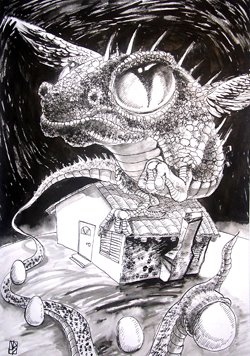
Antigua leyenda de origen probablemente oriental, introducida en Europa por los romanos. Plinio habló del Basilisco y varios artistas se ocuparon de su iconografía. Es un híbrido nacido de la fecundación de un huevo de culebra por un sapo al que se describe como un animal verdaderamente fabuloso, algo semejante al dragón, con patas de gallina y cola de serpiente, una cresta en la cabeza y por lo común provisto de alas, su aliento pudre el aire, envenena las aguas y marchita todo verdor. Huye de la luz del día escondiéndose en los techos de las casas, para fulminar desde allí, con su diabólica mirada a los desdichados que se dejan sorprender.
Antigua legend of probably oriental origin, introduced in Europe by the Romans. Plinio spoke of the Basilisk and several artists were in charge of of its iconography. It is a hybrid one born of the fecundation of a snake egg for a toad to the one that is described as a truly fabulous animal, something similar to the dragon, with hen paws and snake line, a crest in the head and in general provided of wings, their encouragement rots the air, it poisons the waters and it withers all greenery. He/she escapes from the light of the day hiding in the roofs of the houses, to fulminate from there, with their diabolical look to the unhappy ones that are allowed to surprise.
CAÁ YARÍ
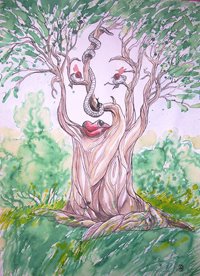
Deidad de origen guaraní, que por modificaciones sufridas en la época de las misiones jesuíticas redujo sus dominios a la yerba mate. En efecto, actualmente sólo frecuenta los yerbales correntinos y misioneros, aunque el fuerte de su leyenda está en Paraguay. Sería una bella joven transformada en dicha planta por Dios, como una forma de asegurarle la eternidad. Para Aníbal Cambas, quien se apoya en relatos de trabajadores, sería una diosa protectora y dueña de los yerbales. Ayuda a los hombres que pactan con ella, para eso es preciso hacer votos ante una mata de yerba de evitar relacionarse en el futuro con otra mujer, y dejar allí un papel con su nombre y la hora en que volverá con el propósito de verla. Hay que armarse de mucho valor para comparecer a la cita, pues para probar el amor del hombre manda sobre él víboras, sapos, tigres y otros animales del monte. Si no huye se le aparece con la forma de una joven hermosa y rubia. El trabajador debe renovar entonces su juramento de fidelidad, y desde aquel día, cada vez que va a cortar yerba cae en dulce sueño, y duerme mientras ella hace el trabajo. Es invisible para todos, menos para este hombre. Si le es infiel con otra mujer, lo matará. Por eso cuando algún trabajador muere en el yerbal, se dice que traicionó a la Caá-Yarí y ésta se tomó venganza.
Deity of Guarani origin that reduced their domains to the dull herb for modifications suffered in the time of the Jesuit missions. Indeed, at the moment only it frequents the yerbales correntinos and missionaries, although the strong of their legend is in Paraguay. He/she would be a beautiful youth become this plant for heaven's sake, like a form of assuring him the eternity. For Aníbal Cambas who leans on in workers' stories, would be a goddess protector and owner of the yerbales. He/she helps the men that make a pact with her, for that it is necessary to make votes before a herb bush of avoiding to be related in the future with another woman, and to leave a paper there with their name and the hour in that it will return with the purpose of seeing it. It is necessary to arm of a lot of value to appear to the appointment, because to prove the man's love it sends on him vipers, toads, tigers and other animals of the mount. If he/she doesn't escape he/she is appeared with the form of a beautiful and blond youth. The worker should renovate his oath of fidelity then, and from that day, every time that will cut herb he falls in candy dream, and he sleeps while she makes the work. It is invisible for all, fewer for this man. If it is he unfaithful with another woman, it will kill him. For that reason when some worker dies in the yerbal, it is said that it betrayed the Caá-Yarí and this took vengeance.
CANCERBERO
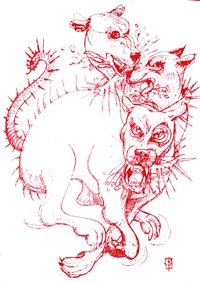
Si el infierno es una casa, la casa de Hades, es natural que un perro al guarde, también es natural que a ese perro lo imaginen atroz. Sacar el cancerbero a la luz del día fue el último de los trabajos de Hércules. Este perro con tres cabezas denota el pasado, el presente y el porvenir, que reciben y, como quien dice, devoran todas las cosas. Que fuera vencido por Hércules prueba que las acciones heroicas son victoriosas sobre el Tiempo y subsisten en la memoria de la Posteridad.
Según textos antiguos, el Cancerbero saluda con el rabo, que es una serpiente, a los que entran en el Infierno, y devora a los que procuran salir, una tradición posterior lo hace morder a los que llegan. Para apaciguarlo, era costumbre poner en el ataúd un pastel de miel.
If the hell is a house, the house of Hades, it is natural that a dog to the one keeps, it is also natural that to that dog they imagine it atrocious. To take out the cancerbero by the light of the day was the last of Hercules' works. This dog with three heads denotes the past, the present and the future that you/they receive and, so to speak, they devour all the things. That it was conquered by Hercules it proves that the heroic actions are victorious about the Time and they subsist in the memory of the Posterity.
According to old texts, the Cancerbero greets with the tail that is a snake, to those that enter in the Hell, and it devours those that try to leave, a later tradition he/she makes it bite those that arrive. To appease it, it was habit to put in the casket a cake of honey.
CENTAURO / CENTAUR
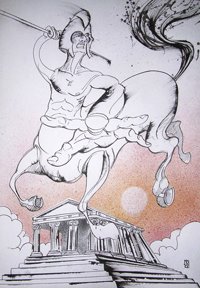
El Centauro es la criatura más armoniosa de la zoología fantástica. Biforme lo llaman las Metamorfosis de Ovidio, pero nada cuesta olvidar su índole heterogénea y pensar que en el mundo platónico de las formas hay un arquetipo del Centauro, como del caballo o del hombre. El descubrimiento de ese arquetipo requirió siglos; los monumentos primitivos y arcaicos exhiben un hombre desnudo, al que se adapta incómodamente la grupa de un caballo.
The Centaur is the most harmonious creature in the fantastic zoology. Biforme calls it the Metamorphoses of Ovidio, but anything hill to forget its heterogeneous nature and to think that in the platonic world in the ways there is an archetype of the Centaur, as of the horse or of the man. The discovery of that archetype required centuries; the primitive and archaic monuments exhibit a naked man, to which adapts the croup of a horse uncomfortably.
CHANCHA CON CADENAS PIG WITH CHAINS
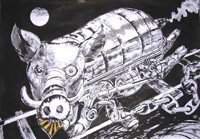
En el norte de Santiago del Estero, se dice que por las inmediaciones de las vías del ferrocarril, en noches de luna llena. merodea una chancha del demonio que arrastra pesadas cadenas con las que hace un ruido espeluznante y aterroriza a los pobladores. Otras versiones dicen que corre como enloquecida por los cables del teléfono.
In the north of Santiago of the Tideland, it is said that for the vicinity of the roads of the railroad, in nights of full moon. the demon's pig that drags heavy chains with those that he/she makes a thrilling noise marauds and it terrifies the residents. Other versions say that he/she runs as gone mad by the cables of the telephone.
FUTRE
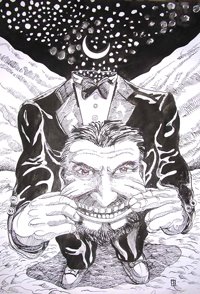
El origen de este mito es mendocino, se sitúa en Puente del Inca, Mendoza, Argentina, y de ahí con diversas variantes, se extendió a otros puntos de la provincia y San Juan. Hay por lo menos dos versiones. Una dice que se trataría de un inglés bien vestido ( de ahí su nombre, pues se llama “futre” en Cuyo, a toda persona que viste elegantemente) que, tras haberlo perdido todo en la sala de juegos del hotel de esa localidad, salió vestido de frac en plena noche y se perdió entre los cerros nevados.
La otra versión dice que se trataba de un hombre humilde que trabajaba en el ferrocarril, que fue asesinado y decapitado por el amante de su esposa en la misma estación de Puente del Inca. Unos dicen que éste anda de noche con la cabeza en la mano y un hacha en la otra, amenazando a los que encuentra, mientras otros aseguran que se trata de un espectro inofensivo. En ambas versiones a veces el Futre aparece a caballo.
The origin of this myth is from Mendoza, it is located in Bridge of the Inca, Mendoza, and of there with diverse variants, he/she extended to other points of the county and San Juan. There is at least two versions. One says that it would be an English very dress (of there their name, because " futre " is called in Whose, to all person that you dressed elegantly) that, after having him lost everything in the room of games of the hotel of that town, tuxedo dress came out in full night and he/she got lost among the snowy hills.
The other version says that it was a humble man that worked in the railroad that was murdered and beheaded by its wife's lover in the same station of Bridge of the Inca. Some say that this walks at night with the head in the hand and an axe in the other one, threatening those that finds, while others assure that it is an inoffensive spectrum. In both versions the Futre sometimes appears to horse.
HUAYRAPUCA
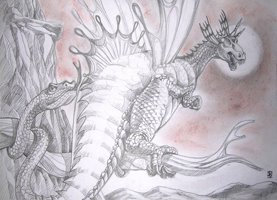
Personaje fabuloso de dos o tres cabezas que puede hacer tanto el bien como el mal. En un extremo de su cuerpo puede tener una monstruosa cabeza de dragón y en el otro una de serpiente. Vive en las altas cumbres y en los profundos abismos montañosos. Sus malos sentimientos se manifiestan cuando destruye las cosechas y se afana por prolongar la sequía. Para conseguir esto se traba en encarnizada lucha con Puyuspa, el nublado, su eterno enemigo. Recorre las llanuras absorbiendo la humedad de plantas y secando la garganta de los animales, que mugen lastimeramente.
Fabulous character of two or three heads that he/she can make so much well the as the wrong. In an end of their body he/she can have a monstrous dragon head and in the other one one of snake. He/she lives in the high summits and in the deep mountainous abysses. Their bad feelings are manifested when it destroys the crops and he/she toils to prolong the drought. To get this it is begun in bloody fight with Puyuspa, the cloudy
KAPARILO
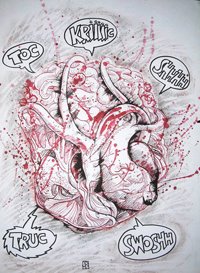
Leyenda de los montes de Copo, en Santiago del Estero. En este ser toman forma todos los ruidos extraños en un ser poco definido, que puede tomar la forma de una bola de carne. entre sus características está la de hacerse invisible, y también la de modular sus gritos de modo que se acerquen y alejen arbitrariamente, sembrando miedo y desconcierto. Suele rondar los ranchos cuando los hombres se han ausentado.
Legend of the mounts of Flake, in Santiago of the Tideland. In this being they take form all the strange noises in a not very defined being that can take the form of a meat ball. among their characteristics it is the one of becoming invisible, and also the one of modulating their screams so that they come closer and move away arbitrarily, sowing fear and bewilderment. It is usually about the ranches when the men have been absent.
KHUMBABA
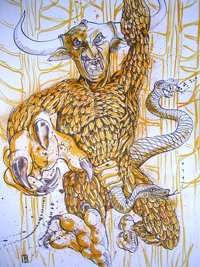
La epopeya babilónica Gilgamesh, dice que Khumbaba era el gigante que guardaba la montaña de los cedros: "Enkidu derribó con el hacha uno de los cedros. -¿Quién ha penetrado en el bosque y ha derribado un cedro?, dijo una voz enorme. Los héroes vieron acercarse a Khumbaba. Tenía uñas de león, el cuerpo revestido de ásperas escamas de bronce, en los pies garras de buitre, en la frente los cuernos del toro salvaje, la cola y el órgano de la generación concluían en cabeza de sierpe."
The Babylonian epic poem Gilgamesh, says that Khumbaba was the giant that kept the mountain of the cedars: "Enkidu demolished with the axe one of the cedars. - Who has it penetrated in the forest and has it demolished a cedar?, did he/she say an enormous voice. The heroes saw Khumbaba come closer. He/she had lion fingernails, the had body of rough brass flakes, in the feet vulture claws, in the forehead the horns of the wild bull, the line and the organ of the generation concluded in serpent head."
LA PERICANA / THE PERICANA
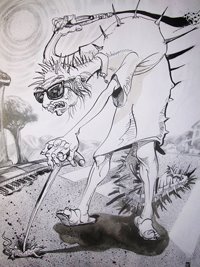
Personaje legendario registrado por Berta Elena de Battini en San Juan y San Luis. Se trata de una vieja horrible, flaca, gigantesca y de largos dientes, que sale por la siesta para correr y castigar duramente con un rebenque, si los atrapa, a los niños que encuentra a esa hora fuera de su casa sin permiso de sus padres o haciendo picardías. Se dice que echa fuego por los ojos, su voz es gruesa. A veces anda con un enorme cuchillo en la mano, seguramente sólo para asustar a los niños, pues no es uno de esos seres que los mata y los come. Se dice también de ella que tiene una cola de clavos y espinas, con la que castiga a los críos hasta dejarlos desnudos y ensangrentados.
Legendary character registered by Berta Elena de Battini in San Juan and San Luis. It is an old one horrible, thin, gigantic and of long teeth that it leaves for the nap to run and to punish difficultly with a whip, if it catches them, to the children that she finds at that hour outside of their house without their parents' permission or making rogueries. It is said that it tosses fire for the eyes, their voice is thick. She sometimes walks with an enormous knife in the hand, surely only to scare the children, because it is not one of those beings that the bush and he/she eats them. It is also said of her that has a line of nails and thorns, with the one that punishes to the críos until leaving them nudes and bloodstained.
LOBISÓN
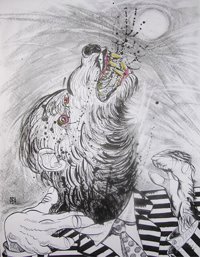
El lobisón u hombre-lobo es siempre el séptimo hijo varón seguido de una pareja. Se lo representa siempre bajo la forma de un perro negro y corpulento, de grandes orejas que cubren la cara. Sus patas se parecen a pezuñas y sus ojos son fulgurantes. La transformación ocurre a las 12 de la noche del viernes, un tiempo antes el hombre que padece esta "enfermedad" experimenta una sensación extraña, y luego una acuciante necesidad que lo lleva a apartarse de sus semejantes, ganar la intimidad del monte, donde a la hora señalada se quitará la ropa y dará en el suelo tres vueltas de derecha a izquierda, mientras reza un credo al revés. Se opera así la metamorfosis y sale entonces de correrías hasta que el canto del gallo lo devuelva a su humana condición.
The lobisón or man-wolf is always the seventh male son followed by a couple. It always represents it to him under the form of a black and stout dog, of big ears that cover the face. Their paws resemble hooves and their eyes are aglow. The transformation happens at 12 in the night of Friday, a time before the man that suffers this " illness " experiences a strange sensation, and then a pressing necessity that takes it to move away from his fellow men, to win the intimacy of the mount, where at the signal hour he will take off the clothes and he will give in the floor three right turns to left, while a credo prays the other way around. It is operated this way the metamorphosis and it leaves forays then until the song of the rooster returns it to its human condition.
LUNG
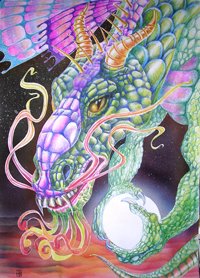
El Dragón Chino, el Luna, es uno de los cuatro animales mágicos de China.
Luna tiene cuernos, garras y escamas, y su espinazo está como erizado de púas. Es habitual representarlo con una perla, la que suele tragar o escupir, en esa perla está todo su poder. Es inofensivo si se la quitan.
The Chinese Dragon, the Moon, is one of the four magic animals of China.
Moon has horns, claws and flakes, and its spine is as bristled of spikes. It is habitual to represent it with a pearl, the one that usually swallows or to spit, in that pearl all their power is. It is inoffensive if they take off it.
ASTERIÓN
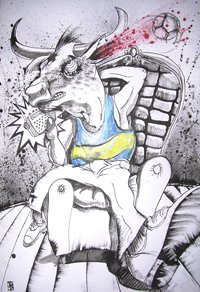
En Creta reinaba el poderoso Rey Minos. Su capital era célebre en el mundo por el laberinto, lleno de intrincados corredores, de los cuales era casi imposible encontrar la salida. En el interior vivía el terrible Minotauro, un monstruo con cabeza de toro y cuerpo de hombre, fruto de los amores de Pasifae, la esposa de Minos, con un toro que Poseidón, dios de los mares, hizo surgir de las aguas. En cada novilunio había que sacrificar un hombre al Minotauro, pues cuando el monstruo no satisfacía su apetito, se precipitaba fuera para sembrar la muerte y desolación de los habitantes de la comarca.
Asterión era el nombre de esta bestia.
In Crete the powerful King reigned Minos. Their capital was celebrated in the world for the labyrinth, full with intricate corridors, of which it was almost impossible to find the exit. In the interior the terrible Minotauro, a monster with bull head and man's body, fruit of the loves of Pasifae, lived the wife of Minos, with a bull that Poseidón, god of the seas, made arise of the waters. In each moon it was necessary to sacrifice a man to the Minotauro, because when the monster didn't satisfy his appetite, he threw outside to sow the death and the inhabitants' of the district desolation. Asterión was the name of this beast.
PACHAMAMA

Madre de la tierra, Madre Tierra, o más exactamente, Tierra Madre. Deidad femenina de origen aymará que alcanzó gran difusión en el Imperio Inca. La Pachamama es la madre de los cerros y los hombres, la que madura los frutos y multiplica el ganado, pudiendo conjurar heladas y plagas y dar suerte en la caza.
Cuenta la leyenda, que los conquistadores españoles sedientos de oro y plata, obligaban a los incas a penetrar las entrañas del cerro Potosí en busca de los preciados metales.
Para que estos minerales nunca se agotaran, la Pachamama los transportaba desde el Cachi al Potosí, a través de secretos túneles. En cierto momento, cuando la explotación alcanzaba un ritmo febril, la Madre Tierra, debió pedir ayuda y entonces convocó a Coquena, protector de las llamas, guanacos y vicuñas. Como él no podía entrar en las cavernas, cargaba el oro y la plata a sus amigas las llamas, en alforjas que ataba, para evitar el robo, con serpientes vivas. Coquena se dedicó con ahínco a su trabajo, y muchos aborígenes lo vieron ir y venir con su figura casi cómica, de enano regordete y su mal genio crónico, con su arreo de llamas y el silbido pegado a los labios.
Mother of the earth, Mother Earth, or more exactly, Earth Mother. Feminine deity of origin aymará that reached great diffusion in the Inca Empire. The Pachamama is the mother of the hills and the men, the one that matures the fruits and it multiplies the livestock, being able to plot icy and plagues and to give luck in the hunt.
It counts the legend that the thirsty Spanish conquerors of gold and silver, they forced the Inca to penetrate the bowel of the hill Potosí in search of the valuable metals.
So that these minerals were never drained, the Pachamama transported them from the Cachi to the Potosí, through secret tunnels. In certain moment, when the exploitation reached a feverish rhythm, the Mother Earth, he/she should request help and then it summoned Coquena, protective of the flames, gumps and vicuñas. As him he/she could not enter in the caverns, it loaded the gold and the silver to their friends the flames, in saddlebags that it tied, to avoid the robbery, with alive snakes. Coquena was devoted eagerly to its work, and many aboriginal they saw it to go and to come with its almost comic figure, of plump midget and its bad chronic genius, with its trapping of flames and the whistle hit to the lips.
PICHAKCHIK

También ARAGANAK-LATEC. Es la madre de las Víboras, personaje de la mitología toba. Se la representa como una mujer de vientre grande y vulva dentada.
Also ARAGANAK-LATEC. He/she is the mother of the Vipers, character of the mythology tufa. It represents it to him like a woman of big stomach and jagged vulva.
PIRA - NÚ
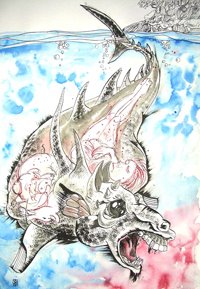
Se traduce como pez negro. Fantasma del agua de la región misionera. Se lo describe como un pez de gran tamaño, con cabeza semejante a la de un caballo, en la que se incrustan enormes ojos. Nada a flor del agua, haciendo zozobrar a las embarcaciones para devorar a las personas y animales que viajan en ellas.
It is translated as black fish. Ghost of the water of the missionary region. It describes it to him as a fish of great size, with head similar to that of a horse, in which enormous eyes are incrusted. Anything to flower of the water, making keel to the crafts to devour people and animals that travel in them.
SÁTIROS / SATYRS
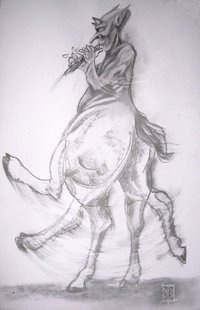
Así los llamaron los griegos. En Roma se llamaron Faunos. De la cintura para abajo eran cabras, el cuerpo, los brazos y el rostro eran humanos y velludos. Tenían cuernitos en la frente, orejas puntiagudas y la nariz encorvada. Eran lascivos y borrachos. Les deleitaba la danza y tocaban diestramente la flauta. Los camerinos los veneraban y les ofrecían las primicias de las cosechas, también les sacrificaban corderos.
The Greeks called this way them. In Rome Fauns were called. Of the waist it stops below they were goats, the body, the arms and the face were human and hairy. They had horns in the forehead, pointed ears and the curved nose. They were lewd and drunkards. It delighted them the dance and they played the flute adeptly. The dressing rooms worshipped them and they offered them the primicias of the crops, they also sacrificed them lambs.
SHORT
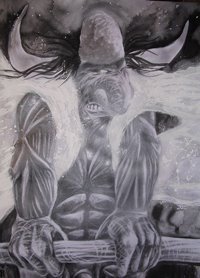
Deidad masculina de los Onas. Es el espíritu de las piedras blancas. Su traje es de este color, pero su cuerpo casi negro, y tiene dos cuernos en la cabeza. Va armado de un palo con el que castiga al que alcanza, como no puede subirse a los árboles, se aconseja a los perseguidos por él treparse a uno de ellos para ponerse a salvo, aunque de ocurrir esto es probable que trate de derribarlo a pedradas. A ningún otro espíritu se le teme más. Se lo describe como muy grueso y de lento caminar.
Masculine deity of the Onas. It is the spirit of the white stones.Their suit is of this color, but its almost black body, and he/she has two horns in the head. He/she goes armed of a stick with the one that punishes the one that reaches, as it cannot be gone up to the trees, he/she seeks advice to those pursued by him to be climbed to one of them to become safe, although of happening this it is probable that it tries to demolish it by stoning. To any other spirit he/she is feared more.It describes it to him as very thick and of slow to walk.
SIRENAS / SIRENS
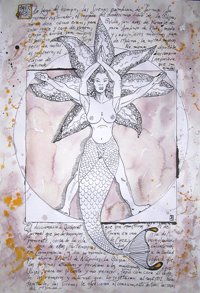
A lo largo del tiempo, las Sirenas cambian de forma. Su primer historiador, el rapsoda del duodécimo libro de la Odisea, no nos dice cómo eran; para Ovidio, son aves de plumaje rojizo y cara de virgen; para Apolonio de Rodas, de medio cuerpo arriba son mujeres y, abajo, aves marinas; para el maestro Tirso de Molina, la mitad mujeres, la mitad pez. El diccionario clásico de Lemprière entiende que son ninfas, el de Quicherat que son monstruos y el de Grimal que son demonios. Moran en una isla del poniente, cerca de la isla de Circe, pero el cadáver de una de ellas, Parténope, fue encontrado en Campania y dio su nombre a la famosa ciudad que ahora lleva el de Nápoles. La Odisea refiere que las Sirenas atraían y perdían a los navegantes y que Ulises, para oír su canto y no perecer, tapó con cera los oídos de los remeros y ordenó que lo sujetaran al mástil. Para tentarlo, las Sirenas le ofrecieron el conocimiento de todas las cosas del mundo.
Along the time, the Sirens change form. His first historian, the rapsoda of the twelfth book of the Odyssey, doesn't tell us how they were; for Ovidio, they are birds of reddish plumage and virgin's face; for Apolonio of Rodas, of half body up are women and, below, marine birds; for the teacher Tirso of Molina, the half women, the half fish. The classic dictionary of Lemprière understands that they are nymphs, that of Quicherat that you/they are monsters and that of Grimal that you/they are demons. They live in an island of the west, near the island of Circe, but the cadaver of one of them, Parténope, it was found in Campania and he/she gave their name to the famous city that now takes that of Naples. The Odyssey refers that the Sirens attracted and they lost the navigators and that Ulises, to hear its song and not to perish, covered with wax the hearings of the rowers and it ordered them to hold it to the mast. To tempt it, the Sirens offered him the knowledge of all the things of the world.
TANGA TANGA

Personaje fabuloso que puede hacer tanto el bien como el mal. Tiene cuello y cabeza de guanaco, cuerpo de avestruz y cola de serpiente. Sus malos sentimientos se manifiestan cuando destruye las cosechas y se afana por prolongar la sequía. Para conseguir esto se traba en encarnizada lucha con Puyuspa, el nublado, su eterno enemigo. Recorre las llanuras absorbiendo la humedad de plantas y secando la garganta de los animales, que mugen lastimeramente.
Fabulous character that can make so much well the as the wrong. He/she has neck and gump head, ostrich body and snake line. Their bad feelings are manifested when it destroys the crops and he/she toils to prolong the drought. To get this it is begun in bloody fight with Puyuspa, the cloudy one, their eternal enemy. It travels the plains absorbing the humidity of plants and the throat of the animals that you/they moo plaintively drying off.
TIGRE AZUL DE ANNAM /THE BLUE TIGER DE ANNAM
En China, para la gente de Annam, tigres o genios personificados por tigres rigen los rumbos del espacio. El Tigre rojo preside el Sur, le corresponden el estío y el fuego. El Tigre Negro preside el Norte y le corresponden el invierno y el agua. El Tigre Blanco preside el Occidente y le corresponden el otoño y los metales. El Tigre Azul preside el Oriente y le corresponden la primavera y las plantas.
Sobre estos tigres cardinales hay otro tigre, el Tigre Amarillo, que gobierna a los otros y está en el centro, como el Emperador que está en el centro de China y China en el centro del mundo. Lao Tsé ha encomendado a los Cinco Tigres la misión de guerrear contra los demonios.
In China, for people of Annam, tigers or geniuses personified by tigers they govern the directions of the space. The red Tiger presides over the South, they correspond him the summertime and the fire. The Black Tiger presides over the North and they correspond him the winter and the water. The White Tiger presides over the West and they correspond him the autumn and the metals. The Blue Tiger presides over the East and they correspond him the spring and the plants.
On these cardinal tigers there is another tiger, the Yellow Tiger, that governs to the other ones and it is in the center, as the Emperor that is in the center of China and China in the center of the world. Lao Tsé has commended the Five Tigers the mission of waring against the demons.
TORO SÚPAY / THE BULL SÚPAY
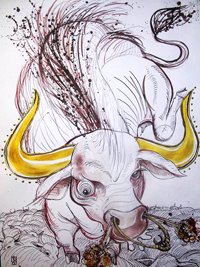
Toro Diablo. Conocido en Santiago del Estero, especialmente en los salvages montes del río Saladillo y el resto de la región saladina. Ricardo Rojas lo describe como de estatura gigantesca, cabeza redonda, entre humana y taurina, de cuello erguido y cola y nuca cerdosas. Echa humo sulfuroso por las narices, y su boca parece una trompa llena de bramidos. Otras descripciones recogidas por Bravo y Franco, destacan sus cuernos de oro.
Protege la hacienda, y le da un grado de prosperidad inalcanzable por medios naturales. Pero es preciso para esto que el dueño de la misma haya realizado un pacto con el Súpay. A la muerte del dueño, éste no sólo cargará con su alma, sino también la hacienda. Al amanecer del día siguiente, mientras dure el velorio, los corrales estarán vacíos.
Bull Devil. Well-known in Santiago of the Tideland, especially in the salvages mounts of the river Saladillo and the rest of the region saladina. Red Ricardo describes it as of gigantic stature, round head, between human and taurine, of erect neck and line and bristly nape. It tosses sulfurous smoke for the noses, and their mouth seems a trumpet full with bellows. Other descriptions picked up for Bravo and Franco, they highlight their horns of gold.
It protects the country property, and he/she gives him a degree of unreachable prosperity for natural means. But it is necessary for this that the owner of the same one has carried out a pact with the Súpay. To the owner's death, this won't only load with their soul, but also the country property. To the dawn of the following day, while the wake lasts, the corrals will be empty.
Subscribe to:
Posts (Atom)





